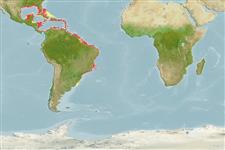Environment: milieu / climate zone / depth range / distribution range
Ökologie
seewasser; süßwasser; brackwasser demersal; amphidrom (Ref. 46888). Tropical; 25°C - 30°C (Ref. 97140); 32°N -
Northwest to western Central Atlantic: Bermuda, Bahamas, South Carolina and northern Gulf of Mexico in USA to southeastern Brazil.
Size / Gewicht / Alter
Maturity: Lm ? range ? - ? cm
Max length : 25.0 cm TL Männchen/unbestimmt; (Ref. 7251); common length : 12.5 cm TL Männchen/unbestimmt; (Ref. 12193)
Rückenflossenstacheln (insgesamt): 7; Rückenflossenweichstrahlen (insgesamt): 9; Afterflossenstacheln 0; Afterflossenweichstrahlen: 9
Adults are found on shallow, muddy or sandy bottoms (Ref. 13628). They appear to prefer estuarine freshwater tributaries, occurring in waters with a salinity range of 0 to 19 ppt (Ref. 7251), or up to 36.6 in some cases (Ref. 97140). Feed on dipteran larvae and pupae (especially the juveniles); crustaceans like crabs and shrimps; and small fishes. The diet changes with sexual maturity and season. Gonadal development takes place during the dry season. Average size at maturity is 5.7 mm for males and 4.3 mm for females (Ref. 35237).
Life cycle and mating behavior
Geschlechtsreife | Fortpflanzung | Ablaichen | Eier | Fecundity | Larven
Robins, C.R. and G.C. Ray, 1986. A field guide to Atlantic coast fishes of North America. Houghton Mifflin Company, Boston, U.S.A. 354 p. (Ref. 7251)
IUCN Rote Liste Status (Ref. 130435)
Bedrohung für Menschen
Harmless
Nutzung durch Menschen
Mehr Information
NamenSynonymeMetabolismusRäuberÖkotoxikologieFortpflanzungGeschlechtsreifeAblaichenSpawning aggregationFecundityEierEientwicklung
PartnerBilderStamps, Coins Misc.LauteCiguateraGeschwindigkeitSchwimmstilKiemenoberflächeOtolithsGehirngrößeSehfähigkeit
Tools
Zusatzinformationen
Download XML
Internet Quellen
Estimates based on models
Preferred temperature (Ref.
123201): 23.4 - 28.1, mean 27.2 °C (based on 808 cells).
Phylogenetic diversity index (Ref.
82804): PD
50 = 0.5000 [Uniqueness, from 0.5 = low to 2.0 = high].
Trophic level (Ref.
69278): 3.7 ±0.4 se; based on diet studies.
Widerstandsfähigkeit (Ref.
120179): mittel, Verdopplung der Population dauert 1,4 - 4,4 Jahre. (Preliminary K or Fecundity.).
Fishing Vulnerability (Ref.
59153): Low vulnerability (15 of 100).
